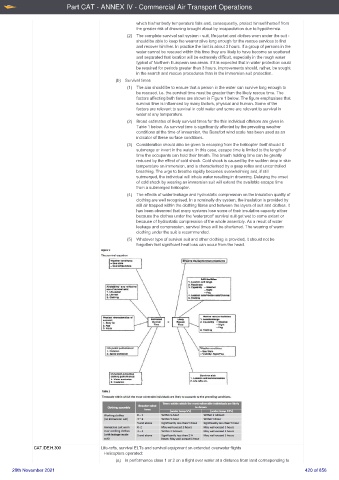Page 420 - UK Air Operations Regulations 201121
P. 420
Part CAT - ANNEX IV - Commercial Air Transport Operations
which his/her body temperature falls and, consequently, protect himself/herself from
the greater risk of drowning brought about by incapacitation due to hypothermia.
(2) The complete survival suit system - suit, life-jacket and clothes worn under the suit -
should be able to keep the wearer alive long enough for the rescue services to find
and recover him/her. In practice the limit is about 3 hours. If a group of persons in the
water cannot be rescued within this time they are likely to have become so scattered
and separated that location will be extremely difficult, especially in the rough water
typical of Northern European sea areas. If it is expected that in water protection could
be required for periods greater than 3 hours, improvements should, rather, be sought
in the search and rescue procedures than in the immersion suit protection.
(b) Survival times
(1) The aim should be to ensure that a person in the water can survive long enough to
be rescued, i.e. the survival time must be greater than the likely rescue time. The
factors affecting both times are shown in Figure 1 below. The figure emphasises that
survival time is influenced by many factors, physical and human. Some of the
factors are relevant to survival in cold water and some are relevant to survival in
water at any temperature.
(2) Broad estimates of likely survival times for the thin individual offshore are given in
Table 1 below. As survival time is significantly affected by the prevailing weather
conditions at the time of immersion, the Beaufort wind scale has been used as an
indicator of these surface conditions.
(3) Consideration should also be given to escaping from the helicopter itself should it
submerge or invert in the water. In this case, escape time is limited to the length of
time the occupants can hold their breath. The breath holding time can be greatly
reduced by the effect of cold shock. Cold shock is caused by the sudden drop in skin
temperature on immersion, and is characterised by a gasp reflex and uncontrolled
breathing. The urge to breathe rapidly becomes overwhelming and, if still
submerged, the individual will inhale water resulting in drowning. Delaying the onset
of cold shock by wearing an immersion suit will extend the available escape time
from a submerged helicopter.
(4) The effects of water leakage and hydrostatic compression on the insulation quality of
clothing are well recognised. In a nominally dry system, the insulation is provided by
still air trapped within the clothing fibres and between the layers of suit and clothes. It
has been observed that many systems lose some of their insulative capacity either
because the clothes under the 'waterproof' survival suit get wet to some extent or
because of hydrostatic compression of the whole assembly. As a result of water
leakage and compression, survival times will be shortened. The wearing of warm
clothing under the suit is recommended.
(5) Whatever type of survival suit and other clothing is provided, it should not be
forgotten that significant heat loss can occur from the head.
CAT.IDE.H.300 Life-rafts, survival ELTs and survival equipment on extended overwater flights
Helicopters operated:
(a) in performance class 1 or 2 on a flight over water at a distance from land corresponding to
20th November 2021 420 of 856

